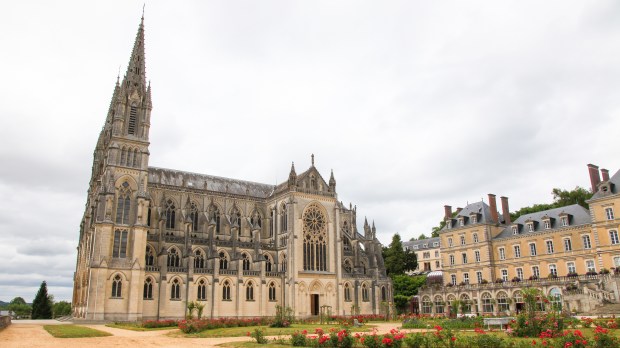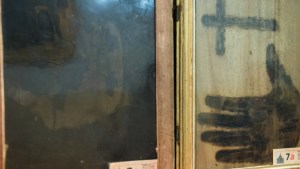Lenten Campaign 2025
This content is free of charge, as are all our articles.
Support us with a donation that is tax-deductible and enable us to continue to reach millions of readers.
The month of November is upon us, and with it comes a special focus on praying for the souls of the deceased in Purgatory. While the principal date for this is All Souls Day on November 2, it’s common to extend this time of prayer throughout the first eight days, or even the entire month. (This year, as last, the Vatican has extended the special indulgences throughout November.) However, there’s one place where praying for the souls in Purgatory is the focus year-round: the shrine and basilica of Our Lady of Montligeon, also known as Our Lady of Deliverance.
This beautiful and unique shrine is found in rural Normandy, 93 miles west of Paris, nestled in the beautiful French countryside in Le Perche Regional Nature Park. Built on a hill, its neo-Gothic spires and buttresses stand out in the landscape, attracting both pilgrims and tourists. However, like many beautiful things, it was born out of tragedy. The shrine’s website and Wikipedia page provide the history of this holy place.
A dedicated pastor
Fr. Paul-Joseph Buguet (1843-1918) was a simple parish priest who was named pastor of the parish of La Chapelle-Montligeon in 1878. It was a small town, and its inhabitants were suffering unemployment and want. Due to the poor conditions, families were accustomed to death and loss—so accustomed that the deceased were often soon forgotten. Fr. Buguet was moved by their spiritual and material plight and wanted to help them and the souls of their beloved departed.
The priest himself was no stranger to grief. In 1876, Fr. Buguet’s brother had been killed by a falling church bell in a neighboring parish, and his two nieces had died afterwards, grief-stricken by their father’s death. This, combined with his experience with his suffering flock, inspired Fr. Buguet to establish a work dedicated to praying for the souls in Purgatory.
The foundation of the association
In 1884, Fr. Buguet’s inspiration took official shape when the statutes of the Association for the Deliverance of Souls in Purgatory were approved. Fr. Buguet set about promoting this spiritual work of mercy, going from parish to parish raising funds to give life to his vision. At the same time, he established a small printing press to publish the literature for his association, thus providing employment for his parishioners.
Pope Leo XIII approved this association as an Archconfraternity in 1893. By then, pilgrims were flocking to Fr. Buguet’s parish to pray to Our Lady of Montligeon, also known as Our Lady of Deliverance, to pray for the deceased. The parish church was inadequate to house the crowds, so with the blessing of his ecclesiastical superiors, Fr. Buguet undertook the construction of a larger church and shrine.
The basilica
On June 4, 1896, the first stone of the shrine’s magnificent neo-Gothic church was blessed and laid. The first Mass would come 15 years later, on June 1, 1911; Pope Pius XI made the church a minor basilica in 1928.
Besides the Blessed Sacrament and the main altar, the focal point of the church is the exquisite white marble statue of Our Lady of Montligeon, the work of Roman sculptor Giulio Tadolini, installed in 1919. The 12-foot-tall statue, and shows Mary holding the Baby Jesus, with two female figures at her feet. One represents a soul in Purgatory; she looks up at Mary in supplication, and the Blessed Mother in turn extends a hand to her. The other, representing the soul freed from suffering and entering heaven, is receiving a crown from the Baby Jesus.
Sending a message to the dead, the Catholic way
The shrine offers many services, including retreats, confession, spiritual direction, and grief counseling (currently only in French, although they welcome groups who wish to organize activities in other languages). Perhaps the most remarkable service is the idea of “sending a card” to someone who is deceased, to say “thank you” or “I’m sorry.”
The website explains the theological basis for this practice, with quotes from the Magisterium: in brief, it highlights the communion of saints and the reality that our deceased loved ones have not disappeared, but have passed into a new state of existence. While we cannot communicate with them in the same way we did before, our relationship continues.
The shrine suggests writing down what we would like to say to those who have gone before us, and entrusting it to God to “forward” our message—of thanks, forgiveness, or asking forgiveness—to our deceased loved one, as well entrusting the prayer to the Blessed Virgin Mary for her intercession.
This can be done in person at the shrine, but also online from anywhere in the world. The website offers a template with instructions for depositing the note in person at the shrine, or sending it in through email or “snail mail.”


